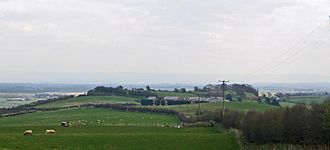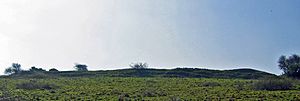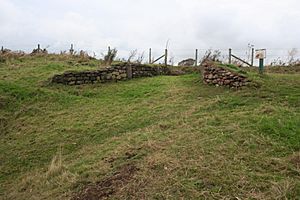Eddisbury hill fort facts for kids
Quick facts for kids Eddisbury hill fort |
|
|---|---|

Eddisbury hill fort from the west
|
|
| General information | |
| Architectural style | Iron Age hill fort |
| Country | England |
| Coordinates | 53°13′13″N 2°40′13″W / 53.220214°N 2.670175°W |
| Technical details | |
| Size | 7 acres (28,000 m2) interior 15.5 acres (63,000 m2) including defences |
Eddisbury hill fort, also called Castle Ditch, is an Iron Age hill fort in Delamere, Cheshire, England. Hill forts were like ancient forts built on top of hills. They were made across Britain during the Iron Age.
Eddisbury is the biggest and most complex of the seven hill forts in Cheshire. It was first built between 200 and 100 BC. It was made bigger between 1 and 50 AD. In the 1st century AD, the Romans partly destroyed it.
People lived there again from the 6th to 8th centuries AD. An Anglo-Saxon fort, called a burh, might have been built here in 914. Later, in the Middle Ages and after, digging for stone and farming caused some damage. Today, parts of the site are owned by the Forestry Commission and a local farm. Eddisbury is a protected ancient monument.
Contents
What is a Hill Fort?
Hill forts started to appear in Britain around 1000 BC. This was during the Late Bronze Age and Early Iron Age. People built them on hills to protect themselves.
Experts have different ideas about why they were built. Some think they were military sites to defend against invaders. Others believe they were built because more people meant less land for farming. This could have caused arguments.
Archaeologist Barry Cunliffe thinks that more people led to social changes. He says hill forts offered protection when tensions turned into fights. But he doesn't think they were built only because there was a war. They were useful strongholds during difficult times.
Where is Eddisbury Hill Fort?
There are over 1,300 hill forts in England. Most are in the south of the country. Only seven are in Cheshire. Eddisbury is the largest and most complex in Cheshire.
Eddisbury hill fort is on Eddisbury Hill. Like all hill forts in Cheshire, it sits on a central ridge. This ridge runs from north to south through the county.
The fort follows the shape of its hill. It is about 200 meters (656 feet) long and 380 meters (1,247 feet) wide. It has two large banks of earth, called ramparts. There is a ditch between them. This ditch is 10 meters (33 feet) wide and 0.5 meters (1.6 feet) deep.
History of Eddisbury
People were active at Eddisbury even in the Bronze Age. Before 250 BC, a wooden fence, called a palisade, was put up on Eddisbury Hill. The first hill fort was built between 200 and 100 BC.
Eddisbury hill fort has two main building periods. In the first period, the site had one rampart and one ditch. This type of fort is called "univallate". The settlement was mainly on the eastern part of the hill.
In the second period, the fort grew towards the west. It then covered the whole hilltop. More ramparts and ditches were added to make the defenses stronger. The protected area grew from 5.5 acres to 7 acres. The defenses covered 15.5 acres in total. This was 6 acres more than before.
This expansion happened between 1 and 50 AD. It likely made the site easier to defend.
In the late 1st century AD, the Romans partly destroyed the hill fort. This is called "slighting".
From the 4th to 6th centuries AD, people lived at the hill fort again. Huts were built over the inner rampart. Another hut from the 6th to 8th centuries was also found.
Eddisbury might have been an Anglo-Saxon burh (fortified town) built in 914. This was done by Æthelflæd, daughter of Alfred the Great. This event is written in the Anglo-Saxon Chronicle.
In later times, parts of the fort were used for farming and quarrying (digging for stone). The center of the fort has been farmed since at least the 1800s.
Eddisbury was dug up by W. J. Varley between 1935 and 1938. He also dug at Maiden Castle nearby. He wanted to learn about the origins of Cheshire's hill forts.
In 1995, Eddisbury was made a Scheduled Ancient Monument. This protects it from being changed without permission. The eastern entrance was dug up again in 2010. Workers found sling stones and a saddle quern (a type of grinding stone). The walls that were dug up were partly rebuilt and can still be seen today.
Experts say the site is "at high risk" because farming causes erosion. Five of Cheshire's seven hill forts are at high risk. This is a higher percentage than other ancient monuments in North West England.
Eddisbury in Stories
Eads Byrig is a burh that is fought over in Bernard Cornwell's book Warriors of the Storm.



